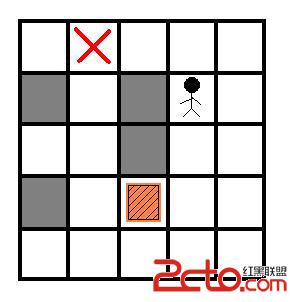推箱子
Time Limit: 2000/1000 MS (Java/Others) Memory Limit: 65536/32768 K (Java/Others)
Total Submission(s): 6386 Accepted Submission(s): 1825
Problem Description 推箱子是一個很經典的游戲.今天我們來玩一個簡單版本.在一個M*N的房間裡有一個箱子和一個搬運工,搬運工的工作就是把箱子推到指定的位置,注意,搬運工只能推箱子而不能拉箱子,因此如果箱子被推到一個角上(如圖2)那麼箱子就不能再被移動了,如果箱子被推到一面牆上,那麼箱子只能沿著牆移動.
現在給定房間的結構,箱子的位置,搬運工的位置和箱子要被推去的位置,請你計算出搬運工至少要推動箱子多少格.

Input 輸入數據的第一行是一個整數T(1<=T<=20),代表測試數據的數量.然後是T組測試數據,每組測試數據的第一行是兩個正整數M,N(2<=M,N<=7),代表房間的大小,然後是一個M行N列的矩陣,代表房間的布局,其中0代表空的地板,1代表牆,2代表箱子的起始位置,3代表箱子要被推去的位置,4代表搬運工的起始位置.
Output 對於每組測試數據,輸出搬運工最少需要推動箱子多少格才能幫箱子推到指定位置,如果不能推到指定位置則輸出-1.
Sample Input
1
5 5
0 3 0 0 0
1 0 1 4 0
0 0 1 0 0
1 0 2 0 0
0 0 0 0 0
Sample Output
4
Author Ignatius.L & weigang Lee
分析:bfs嵌套bfs,一個搜人的軌跡,一個搜箱子的軌跡。
#include
#include
#include
#include
#include
#include
